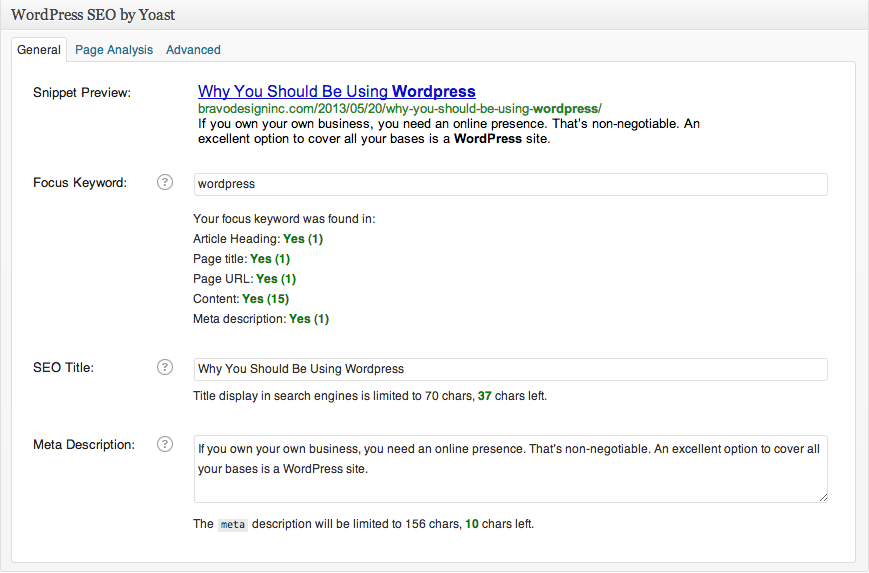If you own your own business, you need an online presence. That’s non-negotiable.
That doesn’t mean you need a website equipped with every bell and whistle, but your online traffic is likely to find you through organic queries, at least in part. And since search is by and large intent based where users know or have a general idea of what they want, basic information should be made available to streamline matchups with potential customers.
A locksmith might post hours of operation and a telephone number via Google Places; a restaurant its menu for customers to peruse through on Yelp or GrubHub; and a graphic design agency a blog for readers to find tips and tutorials or browse through an amazing portfolio that showcases its incredible work. That’s my one shameless plug for the week.
That’s not to say that a locksmith wouldn’t blog. It’s just that the minimum viable product requirements are different for them than, say, a brain surgeon. Primarily, because you’d want to obtain as much information as possible on surgical candidates who would potentially open up your head versus a seemingly interchangeable supply of locksmiths. For those who disagree with this point, make sure to leave a comment in the section below.
In any case, an excellent option to cover all your bases is a WordPress si
 A Live Look at Activity Across WordPress
A Live Look at Activity Across WordPress
WordPress
WordPress is an open-source content management system (CMS) that has taken the world by storm. Known primarily for blogging, it has grown to be much more than that. It powers nearly 66 million websites, with 100,000 more popping up each day. Notable users include: E-Bay, The New York Times, TechCrunch, Reuters, Katy Perry, UPS and a wide array of Fortune 500 Companies. Each month, 371 million people view more than 4.1 billion pages on WordPress sites, and the number of posts created is continuing to trend upwards.
 The Number of Posts WordPress Users Are Publishing
The Number of Posts WordPress Users Are Publishing
It’s Cost Effective.
Because it’s open-source, it’s free to download and use, making it extremely cost-effective even if you do decide to purchase themes or widgets; whereas coding a custom CMS with similar functionality could cost a boatload. It’s robust and professional looking and one of the best ways to manage your SEO on the cheap.
Yoast is a plugin that let’s you optimize page information along with meta descriptions, using snippet preview functionality to see what it would look like in Google. If you have pages you don’t want indexed by search engine robots, you can hide them per page. And lastly, you can canonize pages, distinguishing originals from derivatives. Best of all, it’s free.
 Yoast, “Why You Should Be Using WordPress”
Yoast, “Why You Should Be Using WordPress”
It’s Flexible.
WordPress is extremely flexible and pragmatic. If a specific feature isn’t built-in to a template, there are currently 24,897 plugins available to enhance your site’s functionality making WordPress a serious contender as an e-commerce platform. With active members contributing from around the world, as well as developers for hire, the customization opportunities are endless.
As an FYI, if you’re a developer looking to chat with peers, you can do so via the #WordPress-dev channel on IRC or using #WordPress. If you’re new to the process like myself, sign up at WordPress.org and use the Codex and/or forums to start learning.
It’s Easy to Use.
Prior to working at Bravo Design, Inc., I had zero experience working with CMS no less WordPress, but learning is a piece of cake. Rest assured, you’ll pick it up quickly too. Everything from backend navigation to adding posts, media or tweaking metadata for search engine optimization is really straightforward.
That’s the beauty of WordPress.
This last week, I uploaded my own demo WordPress to tinker around with, marking my third install ever. I’ve done one via WAMP, one through GoDaddy’s easy install and this one onto the Bravo server. While it wasn’t quite done from scratch because I had a pre-configured FTP login, hosting and a tutorial on hand, it was pretty simple. When I say “simple,” I mean a novice could do it and not “simple” as in the way Ikea describes its kitchen installations.
In the coming weeks, we’ll try and upload an easy to use tutorial for those of you who want to install their own WordPress. But for those of you who already have websites, what CMS do you use and why?
Photo Credit: WordPress.org, Webdesign.org